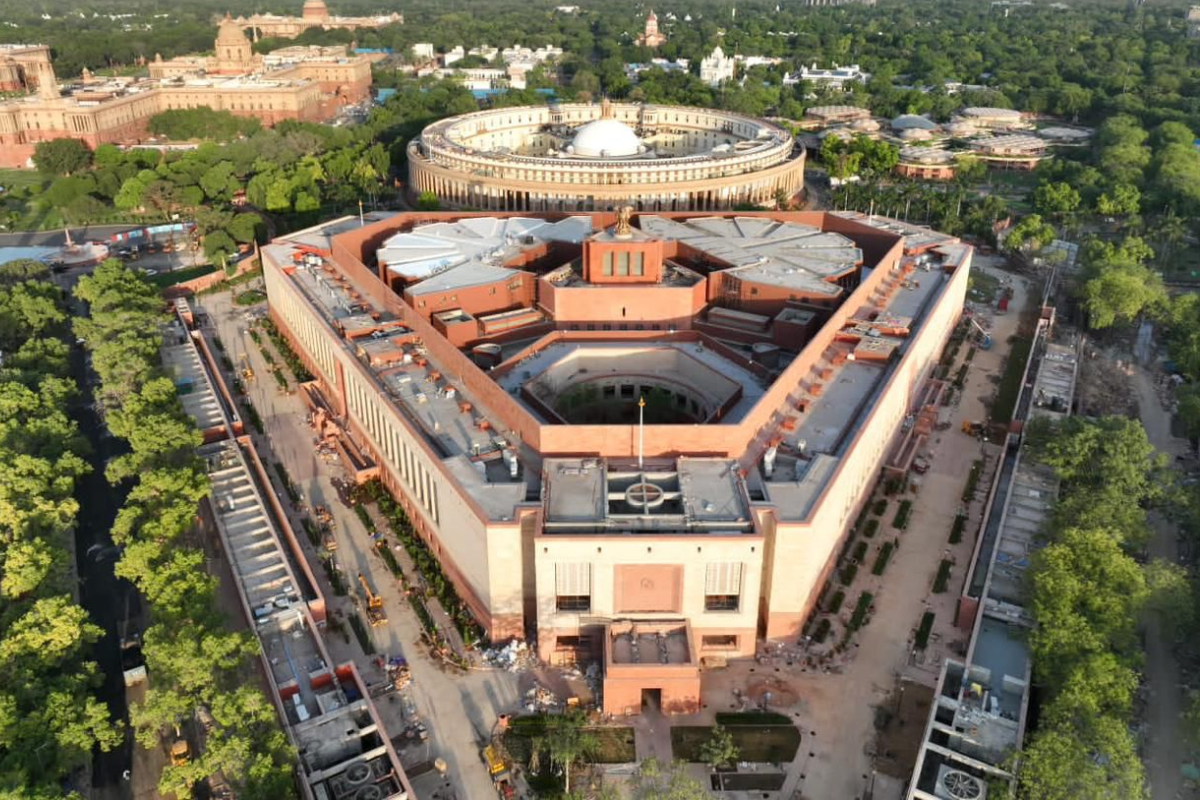India’s new parliament building sprawls across an impressive 64,500 square metres and houses the awe-inspiring Rajya Sabha and Lok Sabha chambers. Drawing inspiration from the profound legacy of ancient India, its design embodies the essence of our culture and iconic symbolism. Embracing progress, the new building will feature six cutting-edge committee rooms, equipped with state-of-the-art audio-visual systems, which marks a significant leap forward from the current structure’s meagre three rooms.
Resplendent symbolism
One notable feature that captivates attention in the new Parliament building is the inclusion of the emblematic “Sengol.” This sacred symbol, representing India’s arduous struggle for freedom and the monumental shift of power from the British, has been reinstated with utmost reverence. Originally gifted to Pandit Nehru by a revered Tamil Nadu Mutt, it now rightfully takes its place behind the speaker’s chair in the Lok Sabha, serving as an unwavering testament to our great nation’s sovereignty.
A captivating bronze mural depicting the “Samudra Manthan,” inspired by Angkor Wat, adorns a prominent wall, commanding attention. As India commemorates 75 years of independence, this compelling narrative prompts us to contemplate the boundless ocean, its mesmerizing aesthetics, and the untapped reservoir of potential that resides within each of us.
A paradigm shift from colonial influence
India’s new parliament building boldly embraces the architectural principles of Vastu Shastra, drawing inspiration from the country’s rich traditions. Its triangular shape pays homage to India’s geometry, while the interiors proudly feature national symbols as central motifs. The Lok Sabha chamber is intricately designed with the graceful peacock motif, while the Rajya Sabha chamber exudes elegance with the enchanting lotus motif. The cultural foyer, themed around the mighty Banyan tree, symbolizes India’s national tree. With six entrances, including three ceremonial ones, the building even bestows distinctive names upon its special entrances: Gyan, Shakti, and Karma.
In contrast, the old parliament building, influenced by British architecture and symbolism, reflected past regimes’ affinity for European liberalism and institutions. In 1919, Lutyens and Baker created a resolute blueprint for the Council House, a circular masterpiece channelling the grandeur of the Colosseum. Unyielding in their vision, they disregarded Indian architectural traditions, deeming them inferior in quality. Under the leadership of Prime Minister Narendra Modi, the current regime has ushered in a new era, granting India’s hard-fought freedom struggle against the British the long-overdue respect it deserves. Challenging colonial ideas and institutions, the regime stands as a testament to the nation’s progress. The Azaadi Ka Amrit Mahotsav serves as a shining example of celebrating our freedom fighters, commemorating their struggles, and honouring their sacrifices.
Pushback by the Opposition
The boycott of the new parliament building inauguration by 20 opposition parties, including Congress, reveals their prioritization of politics over the significance of the occassion. Their grievance lacks legitimacy, as even the Supreme Court dismissed the PIL seeking direction for the new parliament building to be inaugurated by the President. Congress lacks the moral authority to question the inaugural figure, given Nehru’s history of discouraging Chief Ministers from attending the inauguration of the Somnath temple by President Rajendra Prasad. UPA Chairperson Sonia Gandhi herself inaugurated the Chhattisgarh assembly, while the Tamil Nadu assembly and the Assam assembly were inaugurated by her and Tarun Gogoi, respectively. Congress’s history of mistreating Giani Zail Singh and President Fakhruddin’s imposition of an emergency without cabinet meetings is a clear reflection of their disregard for the presidency. However, the real issue at hand is Congress’s frustration with a non-political dynasty Prime Minister like Narendra Modi inaugurating the temple of the world’s largest democracy. This frustration has nothing to do with devaluing the President’s office.
A Synergistic Coexistence
Nevertheless, the government has shown practicality and efficiency by deciding to have both the old and new Parliament buildings coexist harmoniously. This collaboration ensures the smooth and effective functioning of parliamentary operations whenever necessary. Rather than demolishing the old building, it will undergo a remarkable transformation into the prestigious ‘Museum of Democracy,’ preserving its historical significance for future generations. Meanwhile, the new Parliament House will take charge, symbolising progress and growth.
(The writer is a journalist and columnist based in Srinagar. He was honoured with the “Outstanding Media Person Award” by the Jammu & Kashmir Government on Republic Day-2023.)










Wonderfully depicted. always look forward to reading your next article.